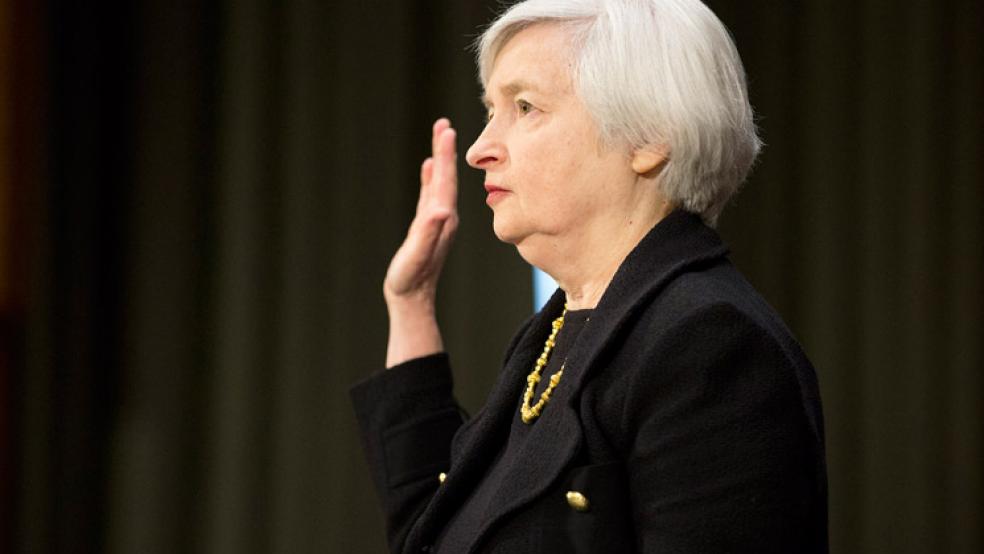Janet Yellen testified for more than two hours Thursday at a Senate Banking Committee hearing on her nomination to succeed Ben Bernanke as chair of the Federal Reserve, and the main message from her remarks can be summed up in one word: continuity.
Yellen has been vice chairwoman of the Federal Reserve for three years and, as Bernanke’s deputy, has played an important role in formulating the central bank’s extraordinary policy responses to the financial crisis and the Great Recession. It’s no surprise, then, that a prepared and composed Yellen strongly defended those policies while emphasizing that she and her colleagues are mindful of the risks they might pose, and of the need for the Federal Reserve to function as a strong financial regulator.
Yellen’s appearance did nothing to rattle the markets or hurt the chances of her confirmation as the first woman ever to lead the Fed. It also did nothing to shed light on when the Fed might begin to pull back on its $85 billion in monthly asset purchases meant to stimulate the economy.
Related: Janet Yellen - Brainy, Brave, and Brooklyn Strong
“Overall, her appearance seemed judged to reassure markets and Republicans on the committee that she would continue with the current Chair Bernanke's approach and wouldn't pursue a more aggressive policy in order to reduce the unemployment rate more quickly,” Paul Ashworth of Capital Economic wrote in a note to clients. “Her composure and ability to handle questions on a wide range of topics should also reassure any lingering doubters.”
Yellen acknowledged the uncertainties involved in “using policies that have never really been tried before,” like those asset-purchase programs known as “quantitative easing” that have ballooned the Fed’s balance sheet to nearly $4 trillion. At the same time, she said that, at this point, the benefits of the extraordinary stimulus programs exceed the costs.
While the labor market has seen “meaningful progress,” Yellen said that the Fed still has more work to do in reducing unemployment. “The message we want to send,” she said, “is that we will do what is in our power to ensure a robust recovery in the context of price stability.”
Those answers did little to clarify just what the Fed’s targets are as it decides on the timing of its tapering. “It would have been more helpful if she could shed some light on exactly what constitutes a meaningful improvement and how that differs from a substantial improvement,” Ashworth wrote. “Is it a certain level of the unemployment rate or a cumulative gain in non-farm payrolls or the recent pace of net gains in payrolls?”
Critics, including Republicans on the Senate panel questioning Yellen, have raised concerns that the asset purchases have inflated the price of stocks and housing and created new economic risks without significantly boosting the economy. “What happens when this morphine drip starts to end?” Sen. Pat Toomey (R-PA) asked, raising the concern that the markets and economy will be riled when the Fed takes away its medicine.
Yellen defended the Federal Reserve’s quantitative easing programs against the idea that they have been “elitist,” “trickle down” policies that have benefitted wealthy investors and asset owners but haven’t helped the average Americans who have been hurt by stagnating wages and low interest rates on savings.
“The objective of our policy is to broadly benefit all Americans, especially those who are seeing harm come to them and their families from high unemployment in a recovery that’s taking a long time and been, frankly, disappointing,” Yellen said.
Related: 4 Questions Janet Yellen Needs to Answer
It’s true, she added, that the Fed’s policies work by driving down interest rates and boosting spending on rate-sensitive assets. “But the ripple effects go through the economy and bring benefits to, I would say, all Americans, both those who are unemployed who find it easier to get jobs as the recovery is stronger but also those who have jobs.”
Yellen also said she didn’t see asset-price bubbles in the economy that could present risks to financial stability, but she emphasized that the Fed and other regulators will be vigilant in monitoring for such risks. “No one wants to live through another financial crisis and the Federal Reserve is devoting substantial resources and time and effort in monitoring those risks,” she said. “At this stage I don’t see risks of financial stability, although there is limited evidence of reach for yield. We don’t see a broad buildup in leverage or the development of risks that I think at this stage poses a risk to financial stability.”
Having defended the Fed’s policies, Yellen gave little indication of when the Fed might tweak them. The Federal Reserve under Bernanke has been criticized for its communication after it surprised the markets in September by not reducing the pace of those asset purchases. “It is a work in progress and sometimes miscommunication is possible,” Yellen said.
Also like Bernanke, Yellen gently took Congress to task for impeding the recovery, reiterating concern that “fiscal policy has been working at cross-purposes to monetary policy.”
“I certainly recognize the importance of the objective of putting the U.S. deficit and debt on a sustainable path,” Yellen said. “But some of the near-term reductions in spending that we have seen have certainly detracted from the momentum of the economy and from demand, making it harder for the Fed to get the economy moving, making our task more difficult.”
Top Reads From The Fiscal Times:





